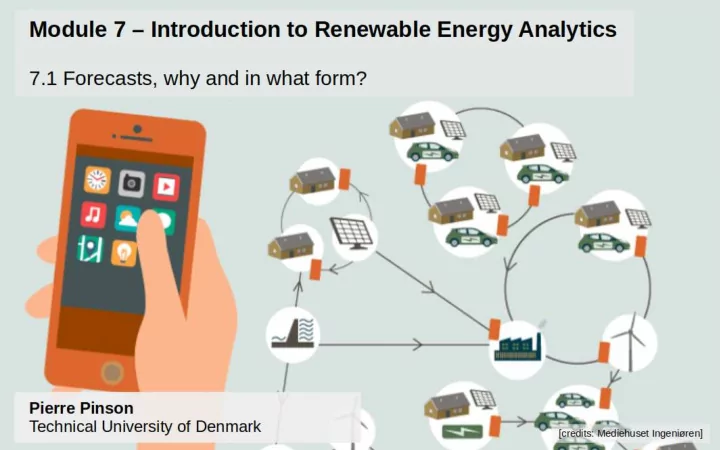

Why forecasting? Forecasting is a natural first step to decision-making Believing we know what will happen helps making decisions but mainly, makes us more confident about it! Key application areas include: weather and climate economics and finance logistics insurance, etc. 2/9
What to forecast? Different actors may have different needs... market participant, supply side (e.g., conventional generator, wind farm operator) market participant, demand side (e.g., retailer) participants in neighboring markets market operator system operator but also, you and I 3/9
What to forecast? Different actors may have different needs... market participant, supply side (e.g., conventional generator, wind farm operator) market participant, demand side (e.g., retailer) participants in neighboring markets market operator system operator but also, you and I One may want forecasts of: the electric load day-ahead prices potential imbalance sign regulation prices/penalties potential congestion on interconnectors etc. Generation from renewable energy sources!!! Nearly all these quantities are driven by weather and climate! 3/9
Renewable energy forecasts in decision-making Forecast information is widely used as input to several decision-making problems: definition of reserve requirements (i.e., backup capacity for the system operator) unit commitment and economic dispatch (i.e., least costs usage of all available units) coordination of renewables with storage design of optimal trading strategies electricity market-clearing optimal maintenance planning (especially for offshore wind farms) Inputs to these methods are: deterministic forecasts probabilistic forecasts as quantiles, intervals, and predictive distributions probabilistic forecasts in the form of trajectories (/scenarios) risk indices (broad audience applications) For nearly all of these problems, optimal decisions can only be obtained if fully considering forecast uncertainty... 4/9
The problem with forecast uncertainty estimation The French National meteorological office (Meteo-France) has been communicating “confidence indices” (indices de confiance) along with their forecasts for quite a while... Example set of forecasts: (from “1 = low confidence” to “5 = high confidence”) Do you get something out of it? 5/9
Now... the “big mouth” paradox It might always be difficult to trust someone providing you with forecasts Even more so if these are probabilistic... Let us consider a simple american setup (focus on New Orleans ), with two rival forecasters: The two competing forecasters tell you that: Forecaster A: It will rain next Monday, and the precipitation amount will be of 22mm Forecaster B: There is a probability of 38% that precipitation is more than 25mm next week Who would you hire? [Extra reading: S Joslyn, L Nadav-Greenberg, RM Nichols (2009) Probability of precipitation: Assessment and enhancement of end-user understanding. Bulletin of the American Meteoreological Society 90 : 185–193 (pdf) UR Karmarkar, ZL Tormala (2010). Believe me - I have no idea what I’m talking about: The effects of source certainty on consumer involvement and persuasion. Journal of Consumer Research 36 (6): 1033–1049 (pdf)] 6/9
Example use of forecasts: market participation Dutch electricity market over the year 2002: day-ahead market APX regulation mechanism managed by TenneT, the TSO for the Netherlands Participation of a 15 MW wind farm , without any storage device and without any control on the power production Point and probabilistic predictions (full predictive distributions) generated with state-of-the-art statistical methods Revenue-maximization strategies based on point predictions only (persistence or advanced method) derived from probabilistic predictions and a model of the participant’s sensitivity to regulation costs 7/9
Trading results Pers. Adv. point pred. Prob. pred. Perfect pred. Contracted energy (GWh) 44.37 45.49 62.37 46.41 Surplus (GWh) 18.12 9.87 4.89 0 Shortage (GWh) 16.08 8.95 20.85 0 Down-regulation costs (10 3 e ) 195.72 119.99 42.61 0 Up-regulation costs (10 3 e ) 79.59 52.01 61.46 0 Total revenue (10 3 e ) 1041.38 1145.69 1212.61 1317.69 Av. down-reg. unit cost ( e /MWh) 10.80 12.15 8.71 0 Av. up-reg. unit cost ( e /MWh) 4.95 5.81 2.95 0 Av. reg. unit cost ( e /MWh) 8.05 9.13 4.04 0 Av. energy price ( e /MWh) 22.44 24.68 26.13 28.37 Part of imbalance (% prod. energy) 73.69 40.55 55.46 0 Performance ratio (%) 79.1 86.99 92.1 100 [Source: P Pinson, C Chevallier, G Kariniotakis. Trading wind generation from short-term probabilistic forecasts of wind power. IEEE Trans. on Power Systems 22 (3): 1148-1156 (pdf)] 8/9
Recommend
More recommend